10 USB Pinout Explained- USB A, B, C(Male and Female)
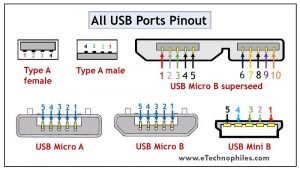
Last updated on April 5th, 2024 at 03:51 pm
Universal Serial Bus (USB) is an electronic device that gives us a universal medium for connecting peripherals. It can be a keyboard, printer, speaker, a storage device, or a mobile phone.
With time, USBs have evolved in type, functionality, and efficiency. So, it becomes important to select the best variant from the available types that perfectly suit our purpose. In this article, we will discuss the pinout of different USB ports or Connectors to get a better idea of their structure and connection.

Table of Contents
The USB pinout can be divided into two parts: USB Connector Pinout and USB port Pinout. The connector here refers to the device that goes into the USB port. For example, a wired Mouse is connected to the laptop by inserting its connector into the USB port.
Hence the terms Male version for Connector and Female version for the USB port are tossed.
USB type A and type B pinout(male and female)
USB Type-A is used to make a connection with a PC while Type B is used to connect smaller peripherals. In other words, Type A is a downstream connector, while Type B is an upstream connector.
The USB type A is rectangular, while type B has a square-like shape. Both of them have 4 pins. The figure below shows the Pinout of Male and Female versions of both USBs.
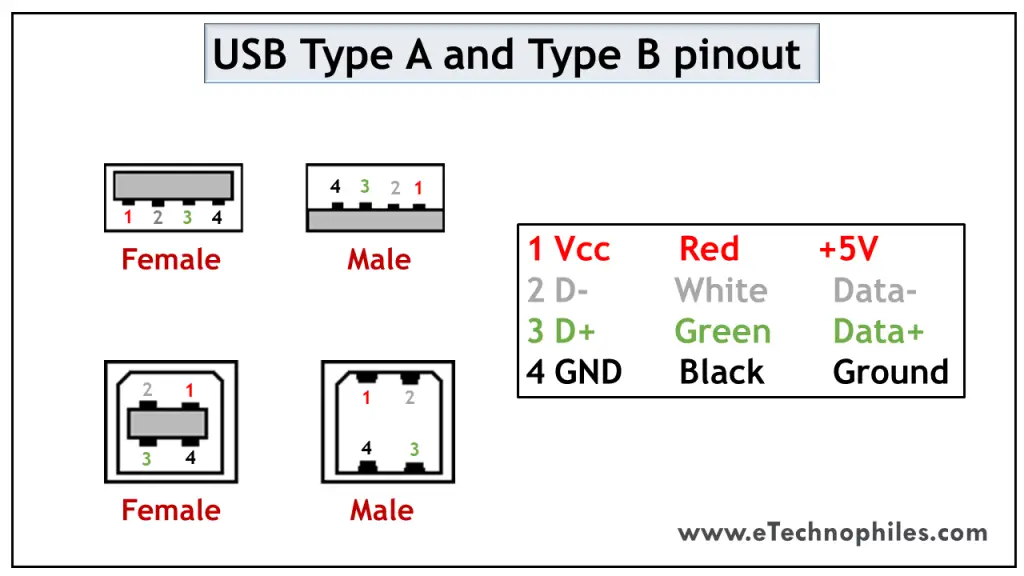
Both these USB types differ in purpose and shape, but their pin connections are the same. Pin 1 is dedicated to the supply and pin 4 is for ground connection. Even pin 2 and 3 take the data input in both these types.
The female port has the PINs in descending order, starting from the right-hand side, while the male connector has them in the reverse order. The table below shows the pinout of both USBs.
USB mini A and mini B
USB Mini was the first improvised version of the normal connectors. This version was launched for both Type A and Type B.
It’s a smaller version of Type A and B, which was extensively used with old mobile phones. The Mini B connector is more popular than the Mini A. The figure below shows the pinout of USB Mini B.
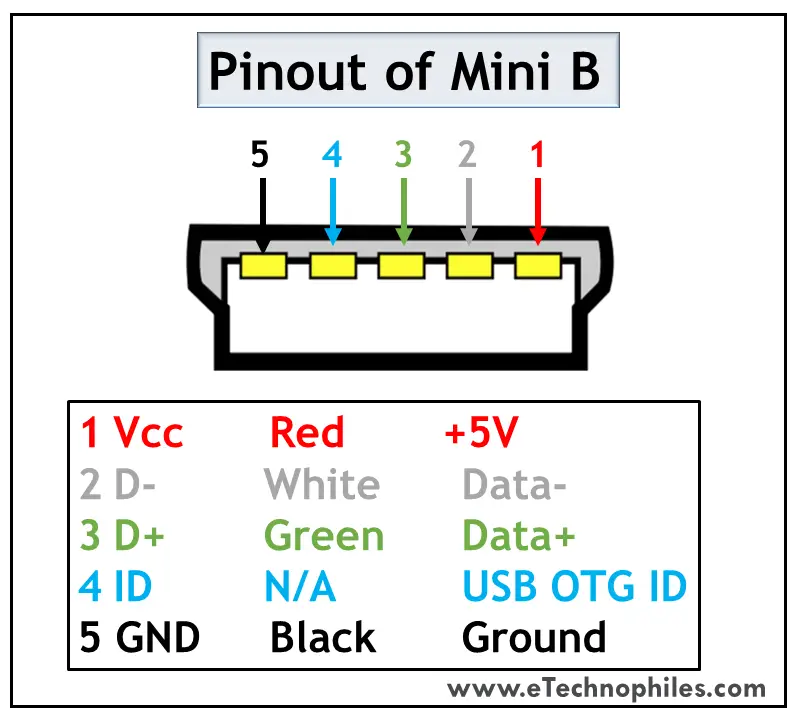
USB Mini B is thinner and more compact than Mini A. Hence it is used for PDAs, digital cameras, etc. Another significant development imposed on Type Mini is that it has an additional pin to support On-the-GO (OTG) connection. Thus it has 5 pins. The pin connections are given in the table below.
USB micro A and micro B
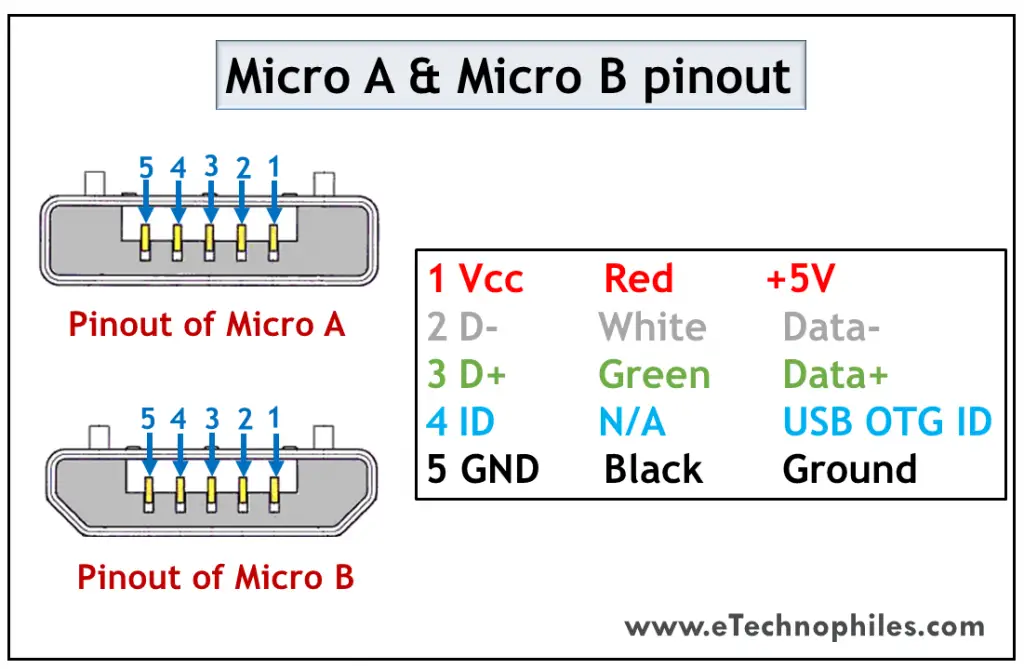
USB Micro is thinner and gives a higher data transfer speed than the USB Mini. It is often used for charging portable devices and comes in two shapes. Micro A is rectangular whereas Type Micro B has a camper shape.
The USB Micro also has 5 pins similar to that of the USB Mini, where the additional pin supports OTG connectivity. The table below shows the pinout of Micro-A and B.
USB standard 3
USB Standard 3 is widely known as the SuperSpeed Mode that brought a revolution in USB manufacturing. The models used in the third generation are highly advanced, offer faster data speed, have a compact design, and are easy to handle.
Features of USB standard 3
The standard 3 models are accepted globally due to the following benefits:
- It is capable of transferring data with a speed of 5Gbps and above.
- Since separate unidirectional paths are used to transmit and receive data, it has a larger bandwidth.
- With predefined power management states, it offers better power management.
- It allows the devices to notify about the data transfer, thereby improving the bus usage.
Standard 3 connectors come in the same physical configuration but with an additional 5 pins to handle these advancements. It includes additional ground and dedicated pins for transmission and reception which are called super-speed connections. ( learn more )
The pinout diagrams of the superspeed versions of different USB types are described in the following section.
USB type A 3.0 and type B 3.0
As discussed above, the normal Type A and Type B connectors have 4 pins. But the superspeed versions of Standard 3 have 9 pins which are visible in the figure below.
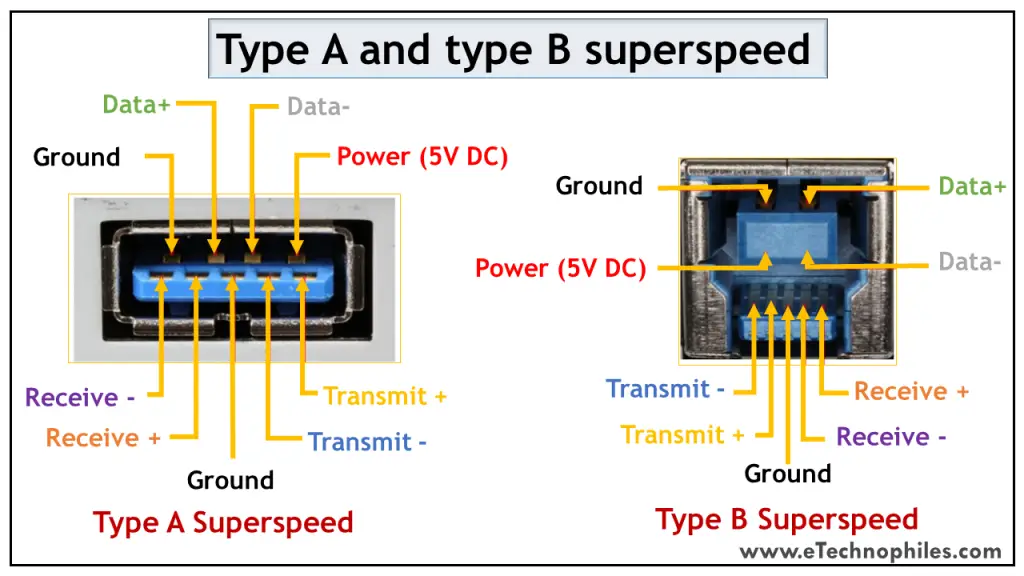
The table below shows the pinout of the superspeed versions.
Micro B 3.0
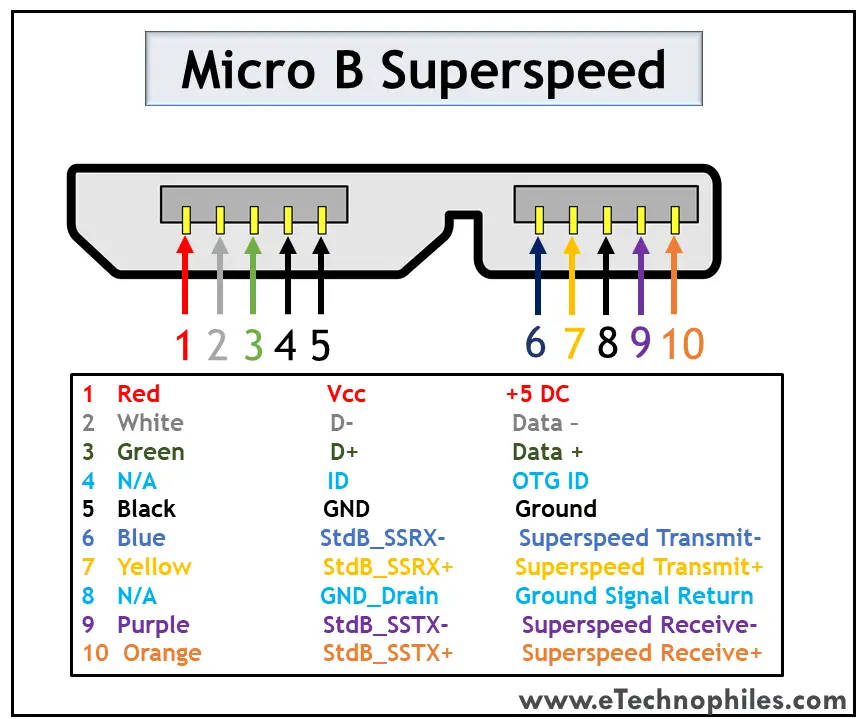
The superspeed version of Micro USB was introduced to Type B. Apart from the existing structure, the five additional pins are placed as an extension. Thus, it has a wider structure. The pinout of the Superspeed Micro B USB connector is given in the table below.
USB type c 3.0
Type C has been the game-changer among all the USB types. It supports data transmission as well as power delivery. Thus, it has become a universal connector for modern devices.

The major attraction of Type C USB is that it is flippable. The figure above shows the pin connections with their corresponding color. The pin connections at the top and bottom are similar, so we don’t have to bother to insert the connector in the correct direction.
It has an incredible data transfer speed of up to 5Gbps and is capable of replacing Ethernet ports to achieve higher data rates. The connection description is given in the table below.
Blessy C Simon
2 thoughts on “10 USB Pinout Explained- USB A, B, C(Male and Female)”
Great knowledge about USB… Thank you
Glad to be of help.
Leave a Comment Cancel reply
PCB Manufacturing
Rigid-flex pcb.
- Heavy Copper PCB
- High Frequency PCB
- High Tg PCB
- Metal Core PCBs
- Aluminum PCBs
- Rogers Material
PCB Assembly
- Custom Cable Assembly
- Custom Wiring Harness
- Capabilities
- Pad Hole Ring Copper
- Pad Hole Ring Copper Specification
- Your Name *
- Phone Number *
- Tell us your needs (as specific as possible) *
- File (Gerber files and BOM need to be compressed into one ZIP file.)
Contact WellPCB Team
Usb pinout: the beginner’s guide.
Nowadays, it’s easy to complete projects that involve creating a physical connection between a host controller and several other bus-powered devices because of the USB interface.
USB stands for Universal Serial Bus and has since replaced its predecessors (FireWire, RS-232 serial, and even parallel) as the primary interface for connecting a host to a device.
Normally, the architecture of a USB system includes a host controller, USB ports, and a wide variety of devices. Also, there are cases where you can add additional USB network hubs to create a tree connection structure.
However, that’s just the surface of it all.
So, in this article, we’ll explain everything about the USB and give different USB examples for your circuits.
Let’s begin!

USB Flash drive
The USB has four shielded wires that work as pins. Two of these wires are for power supply, while the other two are for differential data signal pairs. Check out the table below for the full USB pinout.
How Does a USB Work?

plugging a USB pen drive on a laptop
Like all connectors, all types of USB connectors have male and female types, making sure you connect your devices in the right direction.
It’s essential to make correct USB connections to allow the system to follow the required USB protocol. So, to establish a connection, USB remote devices feature what we call an upstream connection. These remote devices use this upstream connection to connect to a host.
Now, the hosts also have downstream connections that allow them to connect to the remote devices.
Furthermore, you can’t use upstream and downstream connections interchangeably. This helps you avoid misconnections and makes sure you connect the USB cable only in the right direction.
It also helps you avoid several issues like illegal loopback connections and connecting a downstream port to another downstream port.
How it really Works
First, a USB device will show its maximum speed by using pull-up resistors to draw the “D+” and “D-” terminals to 3.3V. Now, the host or hub will also use these pull-up resistors to detect when you connect a compound device to its port. Thus, without a pull-up resistor, the USB won’t detect your connected device or if you have a broken device or broken connector .
So, when you plug in an external device for the first time, the host device scans it and loads the correct driver version required to run the device. To do this, the host uses a product ID/vendor ID (PID/VID)—which the connected hardware or device supplies. Once the host completes the loading of necessary device drivers, the hardware/device will be ready for use.
Note: USB host controllers have their specifications. We have the Universal Host Controller Interface (UHCI), which works for all USB types, the Open Host Controller Interface (OHCI), which works with USB 1.1, and the Enhanced Host Controller Interface (EHCI), which works with USB 2.0.
USB Connector Types
Originally, the USB cable could only be one of two types, and these two types included “Type A” and “Type B”. Afterward, we got the USB C type, which boasted a better data transfer speed with a more robust system.
Check out the table below for the full overview of the different USB types.

Type-A USB Connector Pinout
Type-A USB is the most popular type of USB connector. Plus, you can find them on host controllers, computers, flash drives, and several other items. Also, you can only make downstream connections with the Type-A USB as its sole use is for controllers and hubs.

Flash Drive
Type-A USB connectors are bigger than other connectors and have flat and rectangular shapes. Plus, friction holds this connector in place, making it easy to connect and disconnect. However, using it in areas where your equipment might vibrate isn’t a great idea.
The Type-A USB has two versions: Male and female versions. The male version is the plug, while the female version is what we know as the socket or port.
Female connector versions are what we find on host controllers, while male connector versions are usually on devices like memory sticks, keyboards, mice, and other connections to storage devices.
Applications.
- Works in most personal computers.
- Also works in television and music systems.
- You can also find them on gaming consoles and almost all chargers for mobile portable devices.
Type-A USB Pinout
The older versions of the Type-A connector have four pins, while the newer versions have nine pins. Here’s a table showing all the pins of the Type-A connector.

Note: all generations of the Type-A USB connector have pins 1 to 4 while third-generation connectors have pins 5-9.
USB-B Pinout
The USB-B is the second connector type that mostly works for connecting peripherals like printers and scanners. Plus, their pinouts have a different arrangement.
It has an almost square shape with a slight bevel at the top end corners of the connector. Also, it uses friction to remain in place when connected.
The Type-B USB port is an upstream connector that you can only find on peripheral devices. Thus, most Type-B USB applications require A to B USB cables.
Here’s an interesting fact:
Type-B USB canceled out the chances of creating a connection between two host computers. Thus, helping to prevent damages.
This connector mainly works for peripherals like printers and scanners.
Like the Type-A USB, the older versions of Type-B have four pins, while the newer 3.0 versions have nine pins. Here’s a table showing all the pins:

Also, there is a second type of Type-B connector that has two extra pins:
Source: Wikimedia Commons
USB-C Connector
The USB Type-C is the USB specification that’s slowly replacing the USB-B. It’s a tiny 24-pin reversible plug that works for USB cabling and devices.
Type-C USBs can serve as connectors for both hosts and devices. Plus, you can find Type-C USBs in most recent mobile devices.
USB-C Connector Pinout
The Type-C USB has 24 pins which you can connect reversibly. Here’s a table showing the full list of pins:

Micro USB Pinout
A smaller connector became necessary as the technology required smaller USB sizes for many items like modern mobile phones and audio devices. Thus, the USB Microcontroller was born.
The micro USB has both Type-A and Type-B USB versions available, like the 1.0 micro-USB and 2.0 micro-USB. However, these versions are smaller, and you can use them for much thinner lines of equipment.
Additionally, the micro USB is the USB standard and offers better transfer rates from an external source.
Standard older micro USB connectors have five pins, while the less common 3.0 version has ten pins. Here’s a table showing the pins of the micro USB connector:

The fourth pin mode is what we call the USB on-the-go (OTG). It allows you to switch between the peripheral and host roles on your devices. It’s also what enables devices to decide which will act as a power source once connected. For instance, plugging an android phone into a laptop. The laptop will charge the phone if you have a charge-only cable, not the phone charging the laptop.
Wrapping Up
It’s worth mentioning that sometimes, it’s possible to use USB A to USB A cables to establish connections between a computer or USB device to another USB device with an A-style female port. So you can transfer data between both systems.

However, you shouldn’t use the type A to A cable connection to create connections between two computers or a USB hub and two computers. Why? Well, creating such a connection would mean the cable would receive equal amounts of voltage (5V) from both computers. Thus, connecting both power supplies and causing irreparable damage and other issues. Sometimes, it may even cause a fire hazard.
Well, that wraps up this article. Feel free to reach us if you have any questions, and we’ll be happy to help.

Cras quis nulla commodo
Circuit board fabrication and pcb assembly turnkey services.
To enhance your browsing experience, we use cookies. These cookies may contain your personal information. Please review our Privacy Policy for more information.By clicking "Agree," you acknowledge that you have read and agree to our Privacy Policy and the use of cookies. You can manage cookie preferences anytime in your browser settings.
Get 3 pieces of PCBs for Just $1! 🚀
- 👉 Choose between one or two-layer PCBs.
- 👉 Available in a variety of colors and thicknesses.
- 👉 Board dimensions must be within 100 x 100mm.

- Electronics
USB Pinout | USB 2.0, USB 3.0, Type A, Type B, Mini-B, Micro-B, USB-C
- April 12, 2024
- By Leela Prasad
Universal Serial Bus or simply USB is a popular computer interface that we use to connect a variety of peripherals and devices. Some of the things that we connect using USB are Mice, Keyboard, Printers, Game Controllers , Audio Devices, and many more. Apart from computing devices (laptops, tablets, mobile phones), you can find USBs in cars, bikes, power banks, LED Lights, chargers etc. Depending on the type of application and need, there are several USB ports (USB Type A, Type B, micro-USB, Mini-USB, Type-C etc.). If you are working on anything related to USB, then a knowledge of the USB Pinout is crucial.
In this guide, let us take a quick look at the popular USB Ports and their pinouts. If you are interested in learning about different types of computers ports, then take a look at this 16 Different Types of Computer Ports guide.
A Brief Note on USB
Before the development of USB, we had to deal with separate ports for different types of devices. For example, mice and keyboards had PS/2 Ports, Modems has Serial Ports, Printers had Parallel Ports to name a few.
But with the introduction of USB, this has changed completely. You just need a single port to connect all the aforementioned and many other peripherals and devices to a computer.
From an end-user’s perspective, USB is an easy-to-use interface that supports many devices, is hot pluggable and no fiddling with configuration or settings. You plug-in a device and it just works.
All is not good and positive about USB. There are some negatives as well. For example, the main problem with USB is the different types of connectors it has for different devices (USB A, B, C, Micro, Mini etc.).
This is now changing with the development of USB Type C. We can use USB-C for data transfer, power and charging, connecting to displays, docking stations, etc. with a variety of devices (laptops, smartphones, tablets, computers, cars, external drives, power banks etc.). We believe that USB is finally living up to its “Universal” name with USB Type C.
Different Types of USB Ports
We can divide USB connectors and ports into three types: Type A, Type B and Type C. In both Type A and Type B, there are again three different sizes of connectors intended for different classes of devices. They are: Regular, Mini and Micro.
The connectors are also different based on the version of the USB i.e., USB 1.1 and USN 2.0 have a similar connectors and ports but when it comes to USB3.0, they are completely different. USB Type C sorted this whole mess with a single connector.
Before looking at the USB pinout of different USB ports, here is an image of all the USB Connectors.
Let us now take a look at the pinouts of different USB Ports. We are mentioning the USB Pinout only for the female side of the connection. The pinout of the male side will be identical except that it will be a mirror image of the female side.
USB is the most popular type of connector at the moment. With USB Type C, it is very close to achieving the true “universal” stature for data, power display and many more. In this guide, we saw the basics of USB, different types of USB ports, USB Pinout of different connectors and receptacles.
Related Posts:
- Can USB Port be Converted to HDMI?
- 16 Types of Computer Ports and Their Functions
- Micro HDMI Vs Mini HDMI
- What is USB C? (Introduction, Versions, Pros and Cons)
- What Are the Different USB Types?
- What is a Docking Station
Leave a Reply Cancel reply
Your email address will not be published. Required fields are marked *
Get our Latest Newletters
Get great content that you love. No ads or spams, we promise.

Tutorials Symbols Courses Calculator Deals
Electrical Electronics Embedded Power Robotics ARM IOT
Mini projects Microcontroller Arduino Solar Free circuits Home Automation Seminar Topics Electronics Questions
Capacitors Resistors Filters Diodes Transistors Amplifiers IO Devices Thyristors DC Circuits Number System
Your Privacy is important to us
Tutorials Symbols Courses Calculator
- Affiliate Disclosure
- Terms and Conditions
- Privacy Policy
Copyright © 2024 Electronicshub.org
USB wiring diagram- Micro USB pinout, 7+ Images
If you are searching for the USB wiring diagram, you are at the right place. The wiring diagram includes any combination of different types of USB connectors. The most common after USB-type A to USB- type C is “micro USB- type B ” to standard “ USB-type A ” which is generally presents in mobile phone chargers.
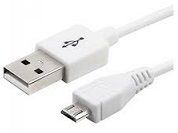
USB wiring diagram comes in handy when USB port or connector either of them malfunctions or completely out of order, also for engineers and hobbyist who wants to explore the electronics wiring practically.
These cables breakdown occurs due to excessive use of USB wire (here excessive use means repetitive use of wire or connecting port in a short duration of time). Improper use like rugged applications, inappropriate inserting into port, i.e without checking port orientation.
Another practice is bending the wire greater than 90 degrees , which causes the copper wires in the bundle to get damaged due to its slightly brittle property. Copper is having one of the best malleability and ductility properties. And therefore copper is widely used as a conductor in a wire even having this property, the copper wire undergoes degradation.
Before wiring USB you need to know the pin-out diagram of USB. Below is the figure showing the pin-out diagram of the USB micro-B and USB-A wiring diagram.
Type-A USB pinout diagram, micro USB pinout diagram along with USB wiring diagram:
This cable is most commonly used in mobile charger for charging mobile phones and as a USB data cable to connect mobile devices to tranfer files and images between personal computers and phones.
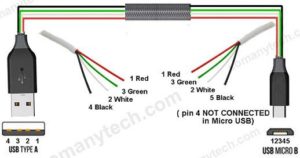
Click here for the USB C 3.0 wiring diagram and charger cable internal wiring.
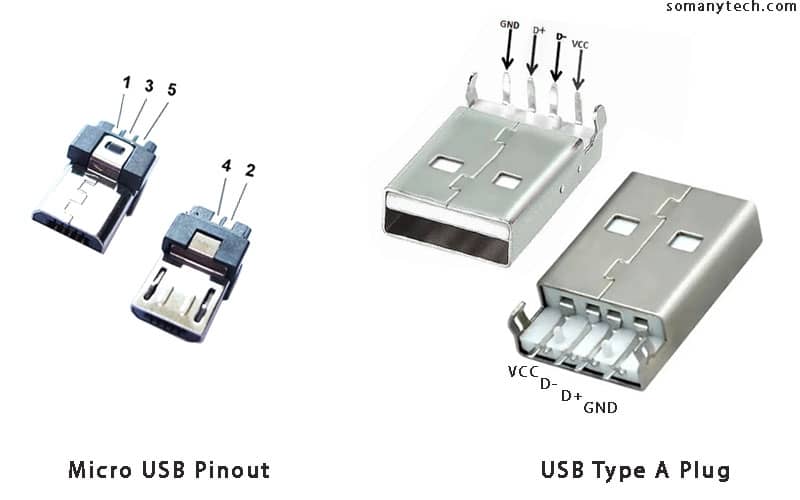
Description : USB wiring is simple but not that simple this is because on changing the frame of reference the pinout looks changed. It can be noticed that pin-out the front side be different than that of back side and thus it requires to check the connectivity of both ends with a digital multi-meter (above micro USB pinout made it simple for you).
Table of male USB-A pinout & USB-B pinout:
The table showing pin number and their nomenclature along with its function in short.
- Pin no.1 showing the power supply ( +VDD ) through that pin the power is supplied to the device or any equipment which is also an indicator of handshake signal, means “the device is connected”.
- According to the USB standard power supply is +5V .(but note that the capacity of the power supply is different for different USB versions)
- Whereas, “ pin no. 2 ” ( -D ) is used as a differential data pin, similarly “ pin no. 3 ” ( +D ) is also used as a differential data pin.
- The work of the differential data pin is to send and receive the data in a particular format called USB protocol.
- Pin no. 4 is used as ground. The color code for the wire used in the USB cable red, white, green, grey, black for pin numbers 1, 2, 3, 4 and 5.
- Please take note of type-A & type-B have the same pinout diagram after arranging on the basis of similarity of shape.
Also check, USB OTG wiring diagram & USB C pin diagram and wiring color code
USB pin-out and its connector:
There are the female connectors for each of the male connectors in practical having the same pin-out as that of the male connector. The most common types of connectors are displayed in this image.
Table of mini and micro USB pin-out type-b & type-a:
The pin-out diagram for the micro USB type-B very similar to USB type-A except for the last two pins 4 and 5 . Also, it is the same for micro USB type-a and micro USB type-b. The pin no.1 is +5V acts as a source to the device or source from the device.
Pin no.2 and pin no.3 are data lines (also called differential data lines because its application varies with the requirements).
The pin no. 4 ( ID ) is used for device identification especially in modern devices for OTG connections. For example, in as a smartphone OTG connector detection to connect a USB drive directly to the mobile phone. And the last pin no. 5 is a connection for ground signal which is pin no. 4 type USB-A through a wire.
How to find the USB wiring diagram manually?
Step1 : First of all find out the type of USB connector used in the cable.
Step2: After the identification of the type of USB connector used on both ends, note down the pinout diagram of that particular USB type.
Step3: Note down all the color of the cable and where it is connected to the actual USB connector on a page. (rough sketch diagram will work)
Step4: Now connect connector pin and wires from the clutter according to the color code and pinout of that particular USB connector on the page using a pen, and your USB wiring diagram is ready.
List of standard USB connectors available commercially in the market which you can buy:
1) USB A male to USB B male. 2) USB A male to USB B female. 3) USB A male to mini USB B male. 4) USB A male to micro USB B male. 5) USB A male to USB C male. 6) USB A female to USB C male. (USB C OTG) and many more.
Micro USB pinout insight and USB-C:
- The micro USB connector is most commonly used for charging mobile phones and various other portable devices like Bluetooth headset, Bluetooth speaker, Mini drones, Power Banks.
- Some of the device manufacturers use their own standard of not connecting the data pin , as the cable is only made to work for charging purposes where only power bus/ wire is required to reduce the manufacturing cost.
You must have had thought of the question, why most of the devices use micro USB?
Most of the devices use micro USB due to the fact that it is compact than all of its precedents in shape and size. And after that, no other type of USB is able to replace it except USB-C ©.
USB-C is more complex micro USB-a than micro USB-b. The micro USB-C is simply called as USB-C.
The image and pinout of micro USB C are as follows:
- You can see a noticeable difference between USB C and micro USB. As you can observe that USB C can be inserted from any of the orientation. On the contrary, micro USB is direction oriented and we have to give attention while inserting it into the device.
- In case if USB C port the Pin no. A1 to A12 is a mirror image of Pin no. B1 to B12. Thus, any functional allocation of pins from A shall be substituted to pins from B.
- USB C has the advantage of orientation, on the other hand, it has the disadvantage of ring complex on the design level for the programmer and engineers.
- Apart from this, micro USB comes in three variants (they have principally same micro USB pinout) as shown in the figure.
- Type-C USB is a new connector system replacing the earlier micro USB. A lot of the new budget smartphones that are released every few weeks have micro USB C ports, they are becoming more popular in the smartphone and gadget category.
- These micro USB C cables are available in different assemblies in different USB versions for various purposes, from USB C charging/ data cable to USB C OTG cable. You can check USB C wiring diagrams and internal wirings of USB 3.0/ 3.1.
The image and pinout of USB b super speed are as follows:
The USB b Superspeed pinout is the combination of USB b and 5 auxiliary pins which are predominantly used in high-speed External Hard Drives . The description section of the table above is self-explanatory.
These variants along with USB wiring diagram are decided by the usb.org , which is a ‘USB standards organization’ that maintains USB standards and improvise the USB technology and its applications.
i) micro a ( USB 1.1 to 2): Previously in mobiles, now discontinued. ii) micro b ( USB 1.1 to 2): All current mobiles/ laptops/ desktop PC. iii) micro b ( USB 3.0): External hard drive/latest smartphone/ laptops.
Important things to consider about USB wiring diagram of cables:
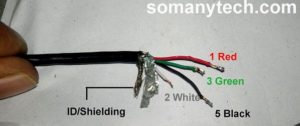
- Check that if you are USB cord has more than 4 wires then 5th one must be a bare/ open conductor. This open wire is generally surrounded to the four main wire from around. This arrangement is called as shielding .
- To prevent external noise shielding is necessary. The most common practice is to ground shielding with the host and external device.
- Shielding is generally avoided in low quality cheaply made USB cables, which is not in the favor of good quality USB cords. It is very important for the protection of data. Also for avoiding loss of data and hardware faults.
USB color code:
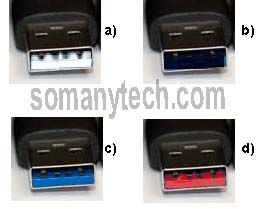
Very few people know that the USB connector has a color code. This color code is given to the USB on the basis of its standards defined by its organization. The colors are white, black, blue, red/ yellow.
White : It was introduced in 1996 (now outdated). It has a very low speed. The version it came from is USB 1.XX.
Black : It was in the market since the year 2000. It’s under version USB 2.XX. Its speed is up to 480 Mbps.
Blue : It published under the version USB 3.XX in 2008. Its maximum speed is 5 Gbps.
Red/Yellow : It is very same as USB3.XX with an upgraded feature of “sleep and charge”. This means that your device with this feature will not stop power supply even if the host device is turned off. This is very helpful for charging the mobile phone according to our convenience.
Related Posts

Blog , Component ID
8205A IC Datasheet PDF, Pin-out & Equivalent Mosfet IC
Here is the detailed information on the features, applications, uses, and specifications of this popular and most commonly found dual Mosfet 8205A IC with datasheet. If you are looking for a high current transistor to use in battery protection, load switching, or power management PCB circuit, this Dual MOSFET is designed in a way to […]

Top 11 Best Scientific Calculator App for Android – 2024
Utilize to the fullest the Android phone with the Best Scientific Calculator App, this app is very useful for Students, Engineers, or anyone requiring to calculate large complex scientific calculations which are more time consuming and not necessary to do manually. This powerful tool combines advanced mathematical functions with a user-friendly interface, making it the […]

Blog , Circuits
TP5100, Schematic, Datasheet, Module, Circuits Diagram
The TP5100 is one of the most widely used battery charging controller IC/ BMS. It is a simple and cost-effective IC that is designed for large current portable electronic devices. One of the main advantages of the TP5100 IC is its compact and simple external circuit, and requires only a few basic additional components to […]

Leviton 4 Way Switch Wiring Diagram & 3 Way Switch Wiring Diagram & PDF
When using a Leviton 4 way switch wiring diagram and setup, you can control the single light fixture from 3 different locations, while two locations can be operated by using a 3 way switch wiring diagram and setup. In this post you’re going to learn the wiring process for Leviton 4-way switch and 3 way […]

Privacy policy
We're sorry but your browser is not supported
To ensure the best online experience possible, please upgrade your browser or contact us.
Tel:1-855-326-4757
Email: [email protected]
Subscribe Today & Save 10% on Your Next Order
- Parametric Search
Product Categories
Circuit Protection
Computers and peripherals, electromechanical, kits and tools, led lighting, optoelectronics and displays, semiconductors, test and measurement, thermal management, tools and supplies, wire and cables, ip&e components.
- Electrical Distribution and Protection
- ESD Protection Diodes
- Overcurrent Protection
- Surge protection Modules
- Computer Products
- Kits & Tools
- Connector Accessories
- I/O Connectors
- Connector Other
- Wire and PCB Connector
- Audio Components
- Electromechanical Switches
- Flow & Level
- Mechanical Power Transmission
- Motion Control and Fluid Power
- Capacitive Encoders (74)
- Magnetic Encoders (35)
- Mechanical Encoders (979)
- Optical Encoders (674)
- Clock and Timing
- Data Conversion Development Boards and Kits
- Development Kits and Tools
- Development Systems
- Embedded System Development Boards and Kits
- Flash Cards
- Power Management Development Boards and Kits
- Programmable Logic Development Boards and Kits
- RF and Microwave Development Boards and Kits
- LED Accessories
- LED Displays
- LED Indication
- LED Lighting
- Lighting Fixtures
- Optoelectronics
- EMI/RFI Suppression
- Oscillators & Crystals
- Power Line Filters
- Power Management
- Power Supplies
- Attenuators
- Communication
- Controllers
- Data Acquisition
- Diodes, Transistors and Thyristors
- Electronic Switches
- Microcontrollers and Processors
- Networks and Interfaces
- Programmable Devices
- RF and Microwave
- Standard and Specialty Logic
- Transceivers
- Accelerometers (868)
- Air Quality Sensors (333)
- Ambient Light Sensors (349)
- Angular and Linear Position Sensors (2238)
- Board Mount Pressure Sensors (4542)
- Color Sensors (83)
- Current Sensors (1344)
- Fan Controllers (377)
- Flow Sensors (216)
- Force Sensors and Load Cells (286)
- Gyroscopes (194)
- Hall Effect Sensors (3261)
- Image Sensors (1652)
- Industrial Pressure Sensors (2568)
- Level Sensors
- Magnetoresistive Sensors (234)
- Photoelectric Sensors (619)
- PIR Sensors (600)
- Proximity Sensors (1697)
- Safety Light Curtains (42)
- Sensor Accessories (1923)
- Sensor and Gateway Kits (30)
- Sensor Development Boards and Kits (3363)
- Sensor Actuator Boxes ()
- Smoke Detectors (109)
- Specialized Sensors (1575)
- Strain Gages (5)
- Temperature and Humidity Sensors (3977)
- Thermistors (9899)
- Thermostats (1482)
- Accessories
- Electrical and Electronic Test Equipment
- Oscilloscopes, Generators and Analyzers
- Fasteners and Hardware
- Materials, Chemicals and Adhesives
- Pipe, Tubing, Hose and Accessories
- Cable Assemblies
- Cable Management Accessories
- Contact Blocks (412)
- Dimmers (20)
- Switch Accessories (8583)
- Switch Detector (561)
- Switch DIP (4754)
- Switch Emergency Stop (214)
- Foot Switches (35)
- Switch Indicators (660)
- Switch Key (850)
- Switch KeyLock (1024)
- Switch Limit (2215)
- Switch Other (468)
- Switch Piezo (102)
- Push Button Switches (8847)
- Switch Reed (629)
- Rocker Switches (4675)
- Rotary Switch (4026)
- Switch Safety Interlock (543)
- Switch Selector (467)
- Switch Slide (2503)
- Snap Action Switch (7936)
- Tactile Switch (5445)
- Switch Thumb-Pushwheel (310)
- Switch Toggle (9319)
Manufacturers Our Featured Partners
19,097 products.
Manufacturers
- Reference Designs
- Articles - Videos - Events
Sorry, there was an error loading the page.
Please refresh the browser and try again. If the problem persists please contact us
Micro USB Pinout Explained

USB cables come with one of five different basic types of USB connector: A, B, mini B, micro B, and C. The micro connector comes standard on most non-Apple mobile phones and many other portables, though USB-C connectors are slowly replacing them in the newest generation of devices.
The USB Standard
The standard micro connector is available only up to the second-generation USB standard, though a less common and much wider 3.0 version exists. The 3.0 version offers:
- Better transfer rates than 2.0, but it’s less practical than the smaller and faster USB-C connector.
- Receptacles that can accept older generation cables, but older receptacles cannot accept 3.0 cables.
The standard micro connector has five pins in its older generations and ten pins in the less common 3.0 generation:

What is USB OTG?
The fourth pin (mode detect) is also commonly referred to as USB “On-the-Go” or simply “OTG.” This pin allows devices to switch between host and peripheral roles. In a smartphone, for instance, the USB connection might allow the phone to perform as a mass storage device when connected to a computer, but as a host to read data from removable storage. This OTG pin is also what allows devices to “decide” which will draw power from the other – typically the host will supply power to the peripheral, though in some cases the roles may be re-negotiated.
Micro USB Pinout Diagrams
Looking at the micro connector on a cable, all generations have pins numbered 1-4, ascending, from left to right on the main trapezoid. Third generation connectors have pins 6-10, ascending, from left to right, on the added side rectangle. You’ll find shielded wires on these connectors, and the data wires (positive and negative) are twisted pairs requiring no termination.

Fig 1: USB A and USB Micro B pinout

Fig 2: USB 3.0 Micro B pinout
Article tags
Related news articles.
- Arduino Corporation
How to Use Raspberry Pi With Arduino Via USB Serial
- Diodes Incorporated
Integrated Solutions to USB Type-C Port Implementation Challenges
- Silicon Motion Technology
- Application Processor and SoC

Silicon Motion's Graphics Display SoCs: Enhancing the User Experience in USB Docking Stations
Usb connector types: mini usb connectors & pinouts, what is a usb c connector usb type c connector standard explained, type b usb connectors & pinouts, modern usb advancements: micro b, c & lightning, type-c usb port mainstream device that triggered exploding demand, important decisions when selecting a fan for forced air cooling, latest news, dc contactor relays: selecting high-voltage dc components.
This article explores DC contactor relays in EV applications, including background, design, protective abilities and more.
- Analog Devices
- Digital Isolation
- Digital Isolator
Understanding the Safety Certification of Digital Isolators
This article explores international safety standards and certifications applying to digital isolators, and provides guidance about using data sheets and specifications to choose the right isolator for an application.
- Power Switches
- ADI Energy Storage and Conversion
Choose a High CMTI Gate Driver That Cuts Your SiC Switch Dead Time
This article explores GaN and SiC technology and how it revolutionizes isolated gate driver ICs.
Arrow Newsletters: Subscribe Now and Save 10%
Connect with electronic components.
Contact and Support
- Contact Arrow
- Find an Arrow Office
- Shipping Information
- Arrow Vendor Registration
- Return Policy
- Accessibility
Programs and Partners
- ArrowSphere
- Electronic Components API
Featured Products
- Internet of Things
- All Products
- LEDs and LED Lighting
- Wire and Cable
- All Categories
- Infineon Technologies AG
- Silicon Labs
- STMicroelectronics
- TE Connectivity
Verticals & Trends
- Energy and Power
- Security Solutions
- Electrification of Everything
- Autonomous Machines
- Smart Everything
- Energy Management
We've updated our privacy policy. Please take a moment to review these changes. By clicking I Agree to Arrow Electronics Terms Of Use and have read and understand the Privacy Policy and Cookie Policy .
- Accept Terms
Our website places cookies on your device to improve your experience and to improve our site. Read more about the cookies we use and how to disable them here . Cookies and tracking technologies may be used for marketing purposes. By clicking “Accept”, you are consenting to placement of cookies on your device and to our use of tracking technologies. Click “Read More” below for more information and instructions on how to disable cookies and tracking technologies. While acceptance of cookies and tracking technologies is voluntary, disabling them may result in the website not working properly, and certain advertisements may be less relevant to you. We respect your privacy. Read our privacy policy here

USB TYPE-C Connector

[Click the image to enlarge it]
USB TYPE-C is a new port designed for high speed data exchange and high power deliver capability. The first thing to realize is that USB TYPE-C is not a new USB standard like USB1.0, USB2.0 , USB3.0, and USB3.1. Those are protocols defining speed and other features, whereas USB TYPE-C is all about physical connection.
USB TYPE-C specification was published by USB Implementers Forum (USB-IF) and was finalized in August 2014. It is a 24 pin USB connector , which is distinguished by its two-fold rotationally-symmetrical connector as shown in above picture.
USB -C connector is designed for replacing USB-A and USB-B connectors. It is also designed for supporting USB3.1 standard fully. It is now poised to become the universal port.
USB Type-C Pin Configuration
As mentioned earlier USB-C is a 24 pin connector and we will describe the each pin below.
The awkward fumble over connecting a pen drive to USB port is finally over with USB-C. The orientation needs to be correct for connecting a pen drive to a USB-A port where as in USB-C port it is not necessary. You can connect devices irrespective of orientation to the USB-C and the port will auto detect the device. So USB TYPE-C is reversible port. Also USB-C is to replace both USB-A and USB-B, so connectivity at both PC and SMART PHONE remains the same. We can connect any end of the cable to PC or SMART PHONE. The issue of connecting correct end of the cable to the PC or MOBILE will be solved permanently with USB-C port.
Features and Electrical Characteristics
- High data transfer speeds up to 10Gb/s
- Up to 5Amp current handling capacity
- Reversible plug orientation and cable direction
- Small size similar to USB2.0 micro-B
- Designed to establish future USB performance needs
- USB-C can replace video ports like VGA and HDMI to provide high quality video output. It can deliver Ultra HD (4K) video for good gaming and movie experience
- USB-C can also replace audio output or 3.5mm jack to provide high quality audio or music in your smart phone or tablet
- USB-C can also replace Ethernet port to provide high speed internet up to 1000Mb/s
- USB-C can also replace SD card port, power port and all other to truly become universal port.
- Operating temperature: -30ºC to +85ºC
Note: Complete technical details can be found in the USB Type-C Connector Datasheet , linked at the bottom of this page.
Brief About USB TYPE-C
USB-C has become the new trend after its introduction. All the latest Laptops, Notebooks, Smart phones, Peripherals, Tablets and Memory devices are tend to be installed with USB-C. We can see new MACBOOK has only a single USB-C port to replace all other ports. In MACBOOK all the functions are done by that single port. Also GOOGLE CHROME BOOK PIXEL and new smart phones are having USB-C to promote for its application in all other areas.
How to use the USB TYPE-C
As mentioned earlier the features provided by USB-C are many. With so many features in a single port comes with complex management. So we need a port controller for using USB-C port. There are different controllers available in the market like TPS65982, FUSB300C and UPD360. We have to choose the appropriate controller depending on the requirement. A typical internal circuitry for USB-C is given below.
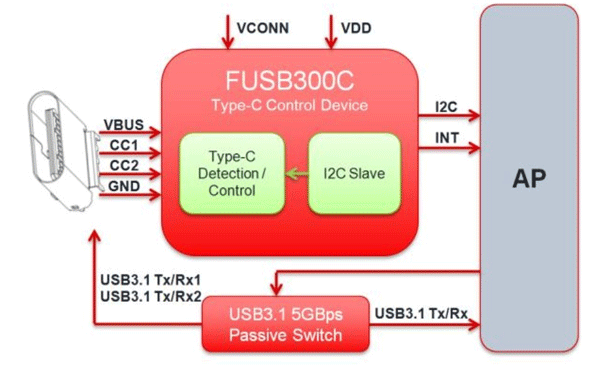
Applications
- Laptops and Notebook
- Personal Computers
- Tablets and Music players
- Printers and Scanners
- Digital cameras
- LCD and LED monitors
- Set top boxes
- Factory automation
- Medical devices
- Data centers
- Power packs and chargers
- Industrial machinery
2-D Model and Dimensions
All measurements are in millimeter
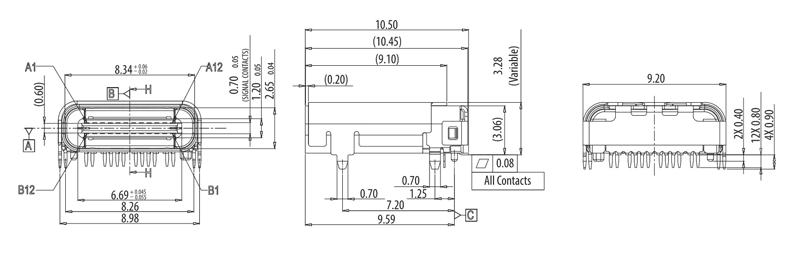
Related Post
Join 20k+subscribers.
We will never spam you.
Be a part of our ever growing community.

Capable of supporting up to 32 GT/s without altering design

3M™ TwinAx High Speed Cable Solutions: Thin, low profile cable with extremely tight bend radii

Advantech's WISE-750 vibration PHM gateway is developed to perform predictive maintenance.

Industrial plating option with enhanced durability for a variety of harsh environments

ECS-3215MV-327KE compact 32.768 kHz MultiVolt oscillators offers low 1.3 µA current consumption.
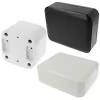
Hammond’s modern 1556 series enclosures are designed for circuit boards and IoT equipment

Optimized with highly sensitive cap touch sensors, extensive peripheral circuits and 125℃ operation

KEMET's automotive PCB-mount relays unique structure offers high performance and productivity
computer bus pin assignment
Usb-c (type-c) pinout.

- Ask a question
USB type-c details
Developed at roughly the same time as the USB 3.1 specification, but distinct from it, the USB Type-C Specification 1.0 defines a new small reversible-plug connector for USB devices. The Type-C plug connects to both hosts and devices, replacing various Type-B and Type-A connectors and cables with a standard meant to be future-proof, similar to Apple Lightning and Thunderbolt . The 24-pin double-sided connector provides four power/ground pairs, two differential pairs for USB 2.0 data bus (though only one pair is implemented in a Type-C cable), four pairs for high-speed data bus, two sideband use pins, and two configuration pins for cable orientation detection, dedicated biphase mark code (BMC) configuration data channel, and VCONN +5 V power for active cables. Type-A and Type-B adaptors and cables will be required for older devices in order to plug into Type-C hosts; adaptors and cables with a Type-C receptacle are not allowed.
USB type-C pinout
Pins A2,A3,A10,A11,B2,B3,B10,B11 are not used with USB 2.0-only devices.
User uploaded image:
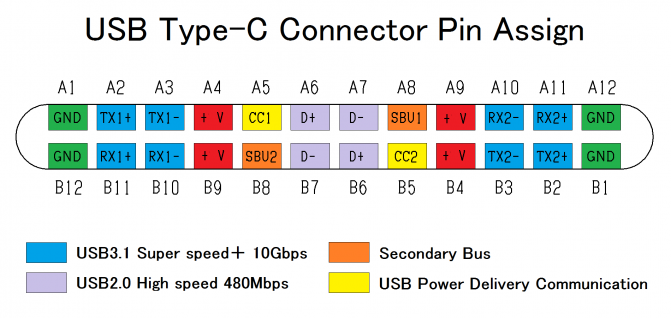
See also USB type C full-featured cable.

- USB-C (type-C) full-featured cable pinout
- USB-C (Type-C) to USB-A charge/data cable pinout
- USB-C to micro-USB 2.0 cable pinout
- USB-C to USB 3.2 cable pinout
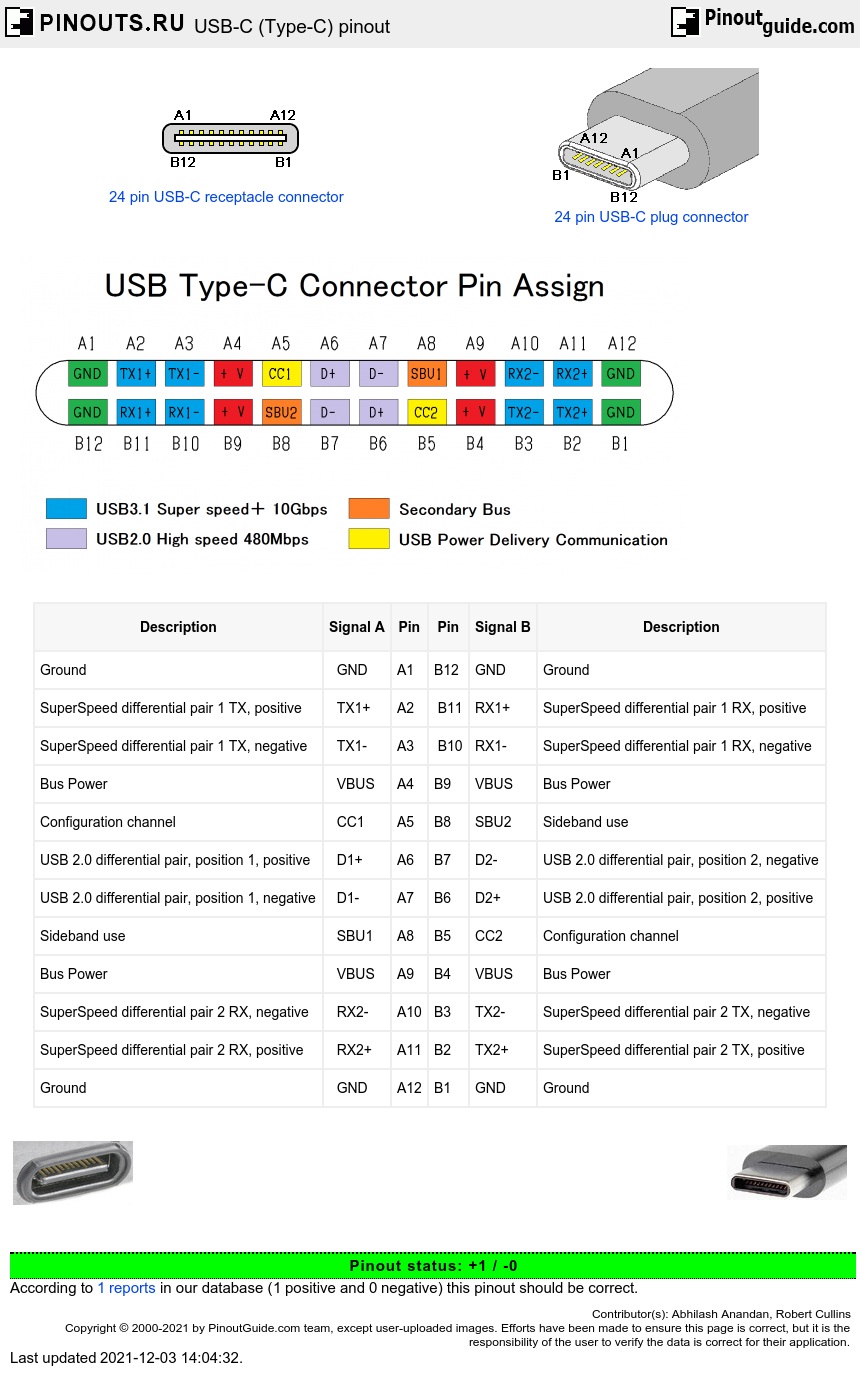

Turn Your Curiosity Into Discovery
Latest facts.
9 Facts About National Train Day May 11th
12 Facts About National Coq Au Vin Day May 29th
40 facts about elektrostal.
Written by Lanette Mayes
Modified & Updated: 02 Mar 2024
Reviewed by Jessica Corbett

Elektrostal is a vibrant city located in the Moscow Oblast region of Russia. With a rich history, stunning architecture, and a thriving community, Elektrostal is a city that has much to offer. Whether you are a history buff, nature enthusiast, or simply curious about different cultures, Elektrostal is sure to captivate you.
This article will provide you with 40 fascinating facts about Elektrostal, giving you a better understanding of why this city is worth exploring. From its origins as an industrial hub to its modern-day charm, we will delve into the various aspects that make Elektrostal a unique and must-visit destination.
So, join us as we uncover the hidden treasures of Elektrostal and discover what makes this city a true gem in the heart of Russia.
Key Takeaways:
- Elektrostal, known as the “Motor City of Russia,” is a vibrant and growing city with a rich industrial history, offering diverse cultural experiences and a strong commitment to environmental sustainability.
- With its convenient location near Moscow, Elektrostal provides a picturesque landscape, vibrant nightlife, and a range of recreational activities, making it an ideal destination for residents and visitors alike.
Known as the “Motor City of Russia.”
Elektrostal, a city located in the Moscow Oblast region of Russia, earned the nickname “Motor City” due to its significant involvement in the automotive industry.
Home to the Elektrostal Metallurgical Plant.
Elektrostal is renowned for its metallurgical plant, which has been producing high-quality steel and alloys since its establishment in 1916.
Boasts a rich industrial heritage.
Elektrostal has a long history of industrial development, contributing to the growth and progress of the region.
Founded in 1916.
The city of Elektrostal was founded in 1916 as a result of the construction of the Elektrostal Metallurgical Plant.
Located approximately 50 kilometers east of Moscow.
Elektrostal is situated in close proximity to the Russian capital, making it easily accessible for both residents and visitors.
Known for its vibrant cultural scene.
Elektrostal is home to several cultural institutions, including museums, theaters, and art galleries that showcase the city’s rich artistic heritage.
A popular destination for nature lovers.
Surrounded by picturesque landscapes and forests, Elektrostal offers ample opportunities for outdoor activities such as hiking, camping, and birdwatching.
Hosts the annual Elektrostal City Day celebrations.
Every year, Elektrostal organizes festive events and activities to celebrate its founding, bringing together residents and visitors in a spirit of unity and joy.
Has a population of approximately 160,000 people.
Elektrostal is home to a diverse and vibrant community of around 160,000 residents, contributing to its dynamic atmosphere.
Boasts excellent education facilities.
The city is known for its well-established educational institutions, providing quality education to students of all ages.
A center for scientific research and innovation.
Elektrostal serves as an important hub for scientific research, particularly in the fields of metallurgy, materials science, and engineering.
Surrounded by picturesque lakes.
The city is blessed with numerous beautiful lakes, offering scenic views and recreational opportunities for locals and visitors alike.
Well-connected transportation system.
Elektrostal benefits from an efficient transportation network, including highways, railways, and public transportation options, ensuring convenient travel within and beyond the city.
Famous for its traditional Russian cuisine.
Food enthusiasts can indulge in authentic Russian dishes at numerous restaurants and cafes scattered throughout Elektrostal.
Home to notable architectural landmarks.
Elektrostal boasts impressive architecture, including the Church of the Transfiguration of the Lord and the Elektrostal Palace of Culture.
Offers a wide range of recreational facilities.
Residents and visitors can enjoy various recreational activities, such as sports complexes, swimming pools, and fitness centers, enhancing the overall quality of life.
Provides a high standard of healthcare.
Elektrostal is equipped with modern medical facilities, ensuring residents have access to quality healthcare services.
Home to the Elektrostal History Museum.
The Elektrostal History Museum showcases the city’s fascinating past through exhibitions and displays.
A hub for sports enthusiasts.
Elektrostal is passionate about sports, with numerous stadiums, arenas, and sports clubs offering opportunities for athletes and spectators.
Celebrates diverse cultural festivals.
Throughout the year, Elektrostal hosts a variety of cultural festivals, celebrating different ethnicities, traditions, and art forms.
Electric power played a significant role in its early development.
Elektrostal owes its name and initial growth to the establishment of electric power stations and the utilization of electricity in the industrial sector.
Boasts a thriving economy.
The city’s strong industrial base, coupled with its strategic location near Moscow, has contributed to Elektrostal’s prosperous economic status.
Houses the Elektrostal Drama Theater.
The Elektrostal Drama Theater is a cultural centerpiece, attracting theater enthusiasts from far and wide.
Popular destination for winter sports.
Elektrostal’s proximity to ski resorts and winter sport facilities makes it a favorite destination for skiing, snowboarding, and other winter activities.
Promotes environmental sustainability.
Elektrostal prioritizes environmental protection and sustainability, implementing initiatives to reduce pollution and preserve natural resources.
Home to renowned educational institutions.
Elektrostal is known for its prestigious schools and universities, offering a wide range of academic programs to students.
Committed to cultural preservation.
The city values its cultural heritage and takes active steps to preserve and promote traditional customs, crafts, and arts.
Hosts an annual International Film Festival.
The Elektrostal International Film Festival attracts filmmakers and cinema enthusiasts from around the world, showcasing a diverse range of films.
Encourages entrepreneurship and innovation.
Elektrostal supports aspiring entrepreneurs and fosters a culture of innovation, providing opportunities for startups and business development.
Offers a range of housing options.
Elektrostal provides diverse housing options, including apartments, houses, and residential complexes, catering to different lifestyles and budgets.
Home to notable sports teams.
Elektrostal is proud of its sports legacy, with several successful sports teams competing at regional and national levels.
Boasts a vibrant nightlife scene.
Residents and visitors can enjoy a lively nightlife in Elektrostal, with numerous bars, clubs, and entertainment venues.
Promotes cultural exchange and international relations.
Elektrostal actively engages in international partnerships, cultural exchanges, and diplomatic collaborations to foster global connections.
Surrounded by beautiful nature reserves.
Nearby nature reserves, such as the Barybino Forest and Luchinskoye Lake, offer opportunities for nature enthusiasts to explore and appreciate the region’s biodiversity.
Commemorates historical events.
The city pays tribute to significant historical events through memorials, monuments, and exhibitions, ensuring the preservation of collective memory.
Promotes sports and youth development.
Elektrostal invests in sports infrastructure and programs to encourage youth participation, health, and physical fitness.
Hosts annual cultural and artistic festivals.
Throughout the year, Elektrostal celebrates its cultural diversity through festivals dedicated to music, dance, art, and theater.
Provides a picturesque landscape for photography enthusiasts.
The city’s scenic beauty, architectural landmarks, and natural surroundings make it a paradise for photographers.
Connects to Moscow via a direct train line.
The convenient train connection between Elektrostal and Moscow makes commuting between the two cities effortless.
A city with a bright future.
Elektrostal continues to grow and develop, aiming to become a model city in terms of infrastructure, sustainability, and quality of life for its residents.
In conclusion, Elektrostal is a fascinating city with a rich history and a vibrant present. From its origins as a center of steel production to its modern-day status as a hub for education and industry, Elektrostal has plenty to offer both residents and visitors. With its beautiful parks, cultural attractions, and proximity to Moscow, there is no shortage of things to see and do in this dynamic city. Whether you’re interested in exploring its historical landmarks, enjoying outdoor activities, or immersing yourself in the local culture, Elektrostal has something for everyone. So, next time you find yourself in the Moscow region, don’t miss the opportunity to discover the hidden gems of Elektrostal.
Q: What is the population of Elektrostal?
A: As of the latest data, the population of Elektrostal is approximately XXXX.
Q: How far is Elektrostal from Moscow?
A: Elektrostal is located approximately XX kilometers away from Moscow.
Q: Are there any famous landmarks in Elektrostal?
A: Yes, Elektrostal is home to several notable landmarks, including XXXX and XXXX.
Q: What industries are prominent in Elektrostal?
A: Elektrostal is known for its steel production industry and is also a center for engineering and manufacturing.
Q: Are there any universities or educational institutions in Elektrostal?
A: Yes, Elektrostal is home to XXXX University and several other educational institutions.
Q: What are some popular outdoor activities in Elektrostal?
A: Elektrostal offers several outdoor activities, such as hiking, cycling, and picnicking in its beautiful parks.
Q: Is Elektrostal well-connected in terms of transportation?
A: Yes, Elektrostal has good transportation links, including trains and buses, making it easily accessible from nearby cities.
Q: Are there any annual events or festivals in Elektrostal?
A: Yes, Elektrostal hosts various events and festivals throughout the year, including XXXX and XXXX.
Was this page helpful?
Our commitment to delivering trustworthy and engaging content is at the heart of what we do. Each fact on our site is contributed by real users like you, bringing a wealth of diverse insights and information. To ensure the highest standards of accuracy and reliability, our dedicated editors meticulously review each submission. This process guarantees that the facts we share are not only fascinating but also credible. Trust in our commitment to quality and authenticity as you explore and learn with us.
Share this Fact:

IMAGES
VIDEO
COMMENTS
USB type A and type B pinout (male and female) USB Type-A is used to make a connection with a PC while Type B is used to connect smaller peripherals. In other words, Type A is a downstream connector, while Type B is an upstream connector. The USB type A is rectangular, while type B has a square-like shape. Both of them have 4 pins.
USB pinouts diagram is a graphical representation of the different pins and their functions in a USB connector. It is essential to understand the pinouts diagram when working with USB cables or devices, as it helps in correctly connecting the wires and ensuring proper functionality. 1. VCC (Power): One of the most important pins in USB pinouts ...
Nowdays there are 7 USB connectors known: Standard-A, Standard-B, Mini-A, Mini-B , Micro-A, Micro-AB, Micro-B, Type-C. Mini-USB pinout and Micro-USB pinout are slightly different: standard USB uses 4 pins while Mini-USB and Micro-USB uses 5 pins in connector. The additional pin is used as an attached device presence indicator.
The USB cable schematic diagram typically includes information about the pin assignments and functions of the four standard USB cable wires: VCC (power), D+ (data), D- (data), and GND (ground). These wires carry power and data signals between USB devices, enabling communication and charging. The schematic diagram also shows the wiring ...
Structure of USB A Pinout. The USB A pinout consists of four pins, each with a unique function: VCC (Pin 1): This is the power supply pin, providing a +5V voltage to the connected device. D- (Pin 2): This is the Data Minus pin, responsible for carrying data. D+ (Pin 3): This is the Data Plus pin, working together with Pin 2 for data transmission.
How to use USB-A Jack. The USB Jack has only three pins and hence is relatively simple to use. Out of the four pin two pins (pin 1 and Pin 4) are used to provide the Vcc and Ground. The supply voltage of Vcc is +5V and is usually provided from the Microcontroller itself. The ground pin is connected to the ground of microcontroller.
USB Pin Assignments. When connecting a USB cable, it is important to understand the pin assignments in order to ensure proper functionality. The Universal Serial Bus (USB) has a standard pin layout that defines the different functions of each pin. The USB 2.0 standard has four pins: Vcc, D-, D+, and Ground.
This connector mainly works for peripherals like printers and scanners. Pinout. Like the Type-A USB, the older versions of Type-B have four pins, while the newer 3.0 versions have nine pins. Here's a table showing all the pins: Also, there is a second type of Type-B connector that has two extra pins: 10. DPWR.
They are: Regular, Mini and Micro. The connectors are also different based on the version of the USB i.e., USB 1.1 and USN 2.0 have a similar connectors and ports but when it comes to USB3.0, they are completely different. USB Type C sorted this whole mess with a single connector. Before looking at the USB pinout of different USB ports, here is ...
USB 3.0 details. USB 3.0 is the third major version of the Universal Serial Bus (USB) standard for interfacing computers and electronic devices. USB 3.0 combines USB 2.0 bus and new SuperSpeed bus with transfer rate up to 5.0 Gbit/s, which is about ten times faster than the USB 2.0 standard. USB 3.0 connectors are usually distinguished from ...
Table of mini and micro USB pin-out type-b & type-a: The pin-out diagram for the micro USB type-B very similar to USB type-A except for the last two pins 4 and 5. Also, it is the same for micro USB type-a and micro USB type-b. The pin no.1 is +5V acts as a source to the device or source from the device.
Though USB-C is more commonly used, USB Type-C is the official name of the standard as listed on USB.org. USB-C Features. The USB-C interface has three main features: It has a flippable connector. The interface is designed in a way that the plug can be flipped relative to the receptacle. It supports USB 2.0, USB 3.0 and USB 3.1 Gen 2 standards.
The standard USB 2.0 Header is a 10 pin .1 pitch header using the standard IDC pin numbering. The header has a key slot on the pin 1-9 side if enclosed. (The 10-pin IDC male graphic shown has the keying on the wrong side). Standard Headers contain two ports each, and have a missing pin for filled female connectors. The standard USB 2.0 Header ...
The USB Standard. The standard micro connector is available only up to the second-generation USB standard, though a less common and much wider 3.0 version exists. The 3.0 version offers: - Better transfer rates than 2.0, but it's less practical than the smaller and faster USB-C connector.
The EZ-PD Configuration Utility makes use of the USB-Serial device to access the Type-C device. Double click on CypressDriverInstaller.exe to start the installation. a. Click Next to continue. b. Click "I agree" after reviewing the license terms. c. Click Install after selecting the destination folder. d.
USB TYPE-C Connector. USB TYPE-C is a new port designed for high speed data exchange and high power deliver capability. The first thing to realize is that USB TYPE-C is not a new USB standard like USB1.0, USB2.0, USB3.0, and USB3.1. Those are protocols defining speed and other features, whereas USB TYPE-C is all about physical connection.
Pin assignments E and F are used with USB Type-C to DisplayPort adapter plugs or receptacles. DisplayPort can use either two or four of the USB-C differential high speed lanes ML0, ML1, ML2 and ML3 for payload data transmission, and the DisplayPort AUX Channel is routed using the USB-C Sideband (SBU) signal
Elektrostal, city, Moscow oblast (province), western Russia.It lies 36 miles (58 km) east of Moscow city. The name, meaning "electric steel," derives from the high-quality-steel industry established there soon after the October Revolution in 1917. During World War II, parts of the heavy-machine-building industry were relocated there from Ukraine, and Elektrostal is now a centre for the ...
Find company research, competitor information, contact details & financial data for BETA GIDA, OOO of Elektrostal, Moscow region. Get the latest business insights from Dun & Bradstreet.
USB type-c details. Developed at roughly the same time as the USB 3.1 specification, but distinct from it, the USB Type-C Specification 1.0 defines a new small reversible-plug connector for USB devices. The Type-C plug connects to both hosts and devices, replacing various Type-B and Type-A connectors and cables with a standard meant to be ...
40 Facts About Elektrostal. Elektrostal is a vibrant city located in the Moscow Oblast region of Russia. With a rich history, stunning architecture, and a thriving community, Elektrostal is a city that has much to offer. Whether you are a history buff, nature enthusiast, or simply curious about different cultures, Elektrostal is sure to ...
Ukrainian military had 64 combat engagements with Russian forces near Synkivka of Kharkiv region, south to Terny and Vesele of Donetsk region, Klischiyivka and Andriyivka of Donetsk region, near Novobakhmutivka, Avdiyivka, Syeverne, Pervomayske and Nevelske of Donetsk region, Heorhiyivka, Pobyeda and Novomykhaylivka of Donetsk region, Staromayorske of Donetsk region, at the east bank of Dnipro ...